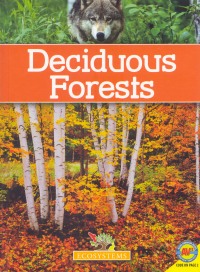| ________________
CM . . . . Volume XVIII Number 32 . . . . April 20, 2012
excerpt:
Deciduous Forests is part of Weigl’s six-volume series on ecosystems and is a revised edition of the 2007 book of the same name. Topics covered include climate, wildlife and environmental threats. Each two-page chapter has photographic images, diagrams and sidebars. When compared to the 2007 edition, some terminology is different (ex. “Ecosystems” instead of “Biomes”; “Eco Facts” instead of “Fascinating Facts”), but the text remains largely unchanged. A “Timeline of Human Activity in Deciduous Forests” is a new feature, but oddly ends at 2002. The major changes to the book appear in the page layout and design and the additional online components. As Deciduous Forests is an “AV² media enhanced” title, readers can gain access to a dedicated website by entering the code found on the page two of the book. Extra features include an audio clip of the first paragraph of each chapter, two short videos, recommended weblinks and downloadable activity sheets. While the print book is a recommended purchase, the “added value” online content is disappointing. The five weblinks are of mixed quality, ranging from authoritative sites, such as NASA and The University of Florida, to the poorly designed and dead-link plagued “Inch in a Pinch”. No citations are provided. By following the instructions to “Click here to read an article about a research project in a deciduous forest”, you are taken to The Tucson News Now site and an article from October of 2010. At the end of the archived article, readers are presented with a list of current news stories that are not always child-friendly. All of the chapters of the print book appear online, but only as small screen shots that are too small to read, and there is no option to enlarge the text. Their only function seems to be as a reminder to follow along in the book. Similarly, the “Words” section takes readers to a screen shot of the glossary at the back of the book. The activity sheets are also neither interactive nor engaging. They require students to fill-in-the-blanks or match words. Compared to all of the new apps and enhanced books on the market, the online presentation here seems very static and outdated. Recommended with reservations. Linda Ludke is a librarian in London, ON.
To comment
on this title or this review, send mail to cm@umanitoba.ca.
Copyright © the Manitoba Library Association. Reproduction for personal
use is permitted only if this copyright notice is maintained. Any
other reproduction is prohibited without permission.
NEXT REVIEW |
TABLE OF CONTENTS FOR THIS ISSUE
- April 20, 2012.
AUTHORS |
TITLES |
MEDIA REVIEWS |
PROFILES |
BACK ISSUES |
SEARCH |
CMARCHIVE |
HOME |
